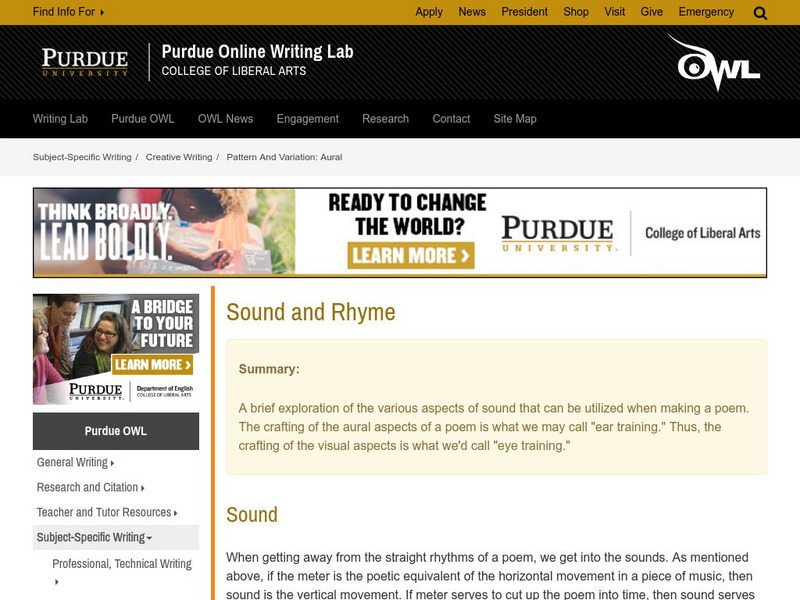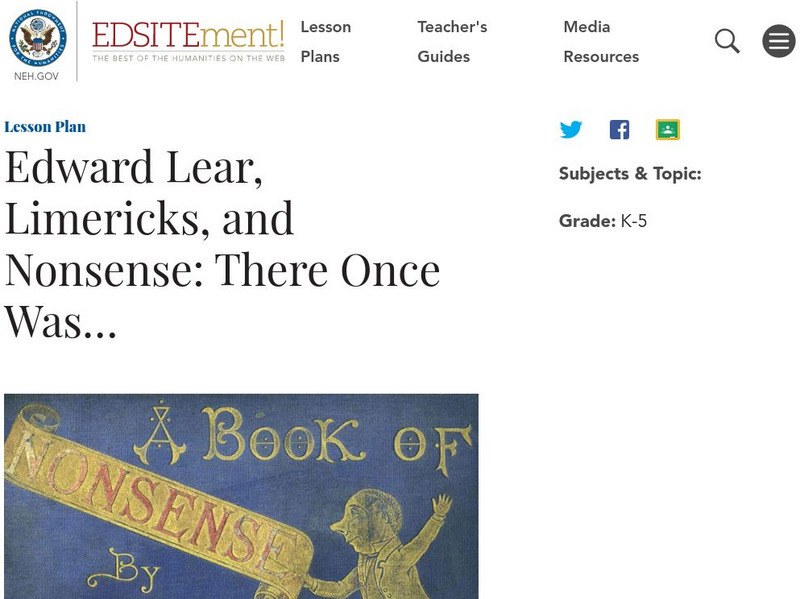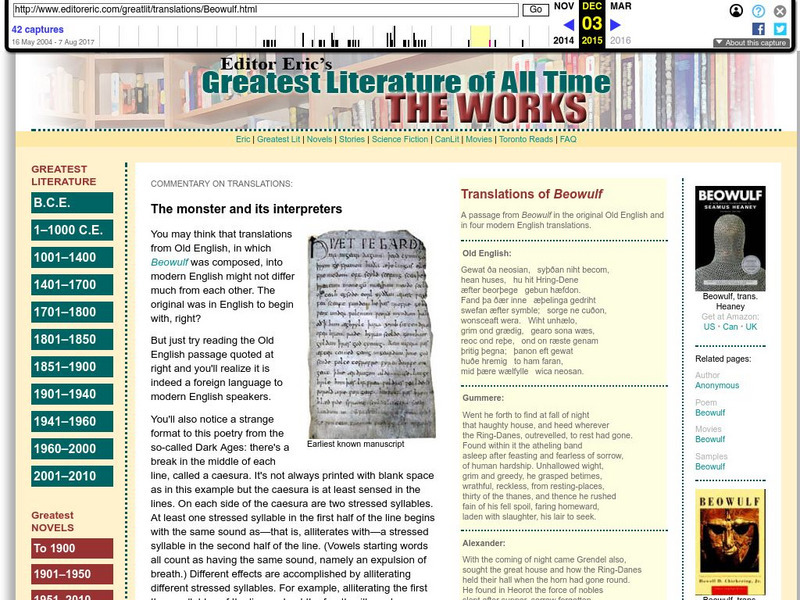Writing Fix
Writing Fix: Noodle Alliteration
This lesson allows students an opportunity to explore the dictionary and thesaurus to write creative alliterations about pasta after reading Jack Prelutsky's poem, "Spaghetti, Spaghetti."
Alabama Learning Exchange
Alex: Producing Poetic Podcasts (Hey, That's Alliteration!)
In this culminating lesson for a poetry unit, students will create a video podcast that summarizes a specific poem, analyzes the poet's use of literary elements, and infers the meaning of the poem (theme). The podcast must use a talk...
Georgia Department of Education
Ga Virtual Learning: Anglo Saxon Poetry
This lesson focuses on Anglo-Saxon poetry including its elegiac tone, exile themes, and use of figurative language and poetic techniques like alliteration, caesura and kennings. It features links to three poems, each in at least two...
SMART Technologies
Smart: Poetry Games
Students will use this interactive exercise to play with words to strengthen their imaginations and their enjoyment of poetry in this SMART whiteboard activity.
Online Writing Lab at Purdue University
Purdue University Owl: Sound & Rhyme
This lesson discusses the use of sound in poetry, mainly focusing on the use of rhyme. Various kinds of rhyme are defined (rhyme scheme, perfect rhyme, forced rhyme, slant rhyme, masculine rhyme, feminine rhyme, visual rhyme, and...
BBC
Bbc: Gcse Bitesize: Alfred, Lord Tennyson: "The Charge of the Light Brigade"
Study the conventions of poetry with Lord Tennyson's "The Charge of the Light Brigade". In preparation for the British GCSE test, this site offers a great tutorial for students learning about alliteration, emotion, historical context,...
CommonLit
Common Lit: "Truth" by Nikki Grimes
This poem appeared in Grimes' book "One Last Word", a collection inspired by poems from The Harlem Renaissance that follow the "Golden Shovel" form. In this poetic form, the poet takes a "striking line" from an inspirational poem and...
Georgia Department of Education
Ga Virtual Learning: Brit Lit: 20th Century Postmodernism: Dylan Thomas
This lesson from a 20th Century Postmodernism unit focuses on Dylan Thomas and his poetry. It provides links to his biography, two of his poems, and a literary analysis assignment pertaining the literary devices and voice in Thomas's...
National Endowment for the Humanities
Neh: Edsit Ement: Analyzing Poetic Devices: Robert Hayden and Theodore Roethke
Students examine the relationship of poetic form and content, shaped by alliteration, consonance, repetition, and rhythm, in two poems about fatherhood: Robert Hayden's "Those Winter Sundays" and Theodore Roethke's "My Papa's Waltz."
Georgia Department of Education
Ga Virtual Learning: Beowulf Introduction
This is an introduction to Beowulf, an epic and alliterative poem in the Old English from the 11th century. It features a link to the British Library with an image of the manuscript and information about Beowulf.
Other
Forgotten Ground Regained: Viking Verse
This site shares poems written in the language and style of the Vikings. Translations and links to other poems that relate to the Viking theme and verse formats are also included on this site.
Academy of American Poets
Poets.org: "Morning Song" by Sylvia Plath
This site shares the poem "Morning Song" from the author Sylvia Plath. Alliteration and rhyme are prevelant in this poem, just as these poetic devices are present in her most famous novel, The Bell Jar.
Love To Know Media
Your Dictionary: Literary Terms Lesson Plan
This is a lesson plan for teaching the seven literary terms used in poetry: simile, metaphor, alliteration, imagery, hyperbole, personification, and onomatopoeia.
National Endowment for the Humanities
Neh: Edsit Ement: There Once Was...
Part 2 of this tutorial on limerick writing demonstrates the importance of form (meter and rhyme) in limerick poetry using the exemplary and amusing work of Edward Lear.
Other
Editor Eric:commentary on Translations: Beowulf:the Monster and Its Interpreters
This article by Eric McMillan focuses on comparing the translations of Beowulf with passages from the original Old English translation and four other translations. He discusses translations in poetry and in prose, with alliteration and...
CommonLit
Common Lit: Columbus
CommonLit.org is a wonderful resource to use in a Language Arts classroom. Each story, poem, or article is accompanied by guided reading questions, assessment questions, and discussion questions. In addition, students can click on words...
Other
Teachersfirst: The Interactive Raven
This site highlights the vocabulary and sound techniques that Poe used to create his well-known poem "The Raven." See if you can identify the devices in the last part of the poem.
Other
Teachers First: The Raven: An Interactive Study Resource
This resource for teaching Poe's "The Raven" marks his use of literary devices and vocabulary. As students cursor over highlighted words, vocabulary is defined and the uses of assonance, alliteration, and internal rhyme are pointed out....
Other
Bob's Byway: Glossary of Poetic Terms
Calling itself "unique," Bob's is easy to use, with cross-links throughout, phonetic pronunciation guides when necessary, and many examples and quotations. Click on the letter and scroll for the word.
Scholastic
Scholastic: Chants and Street Rhymes [Pdf]
Four pages of with chants and street rhymes. Three of the pages are reproducible examples and information useful to students, and one page gives lesson ideas for teachers.

















![Scholastic: Chants and Street Rhymes [Pdf] Lesson Plan Scholastic: Chants and Street Rhymes [Pdf] Lesson Plan](https://content.lessonplanet.com/knovation/original/235777-009e8269cd1a92699375576104471b3b.jpg?1661409426)